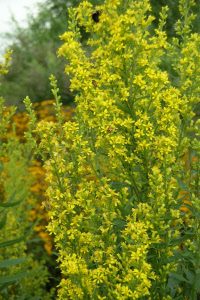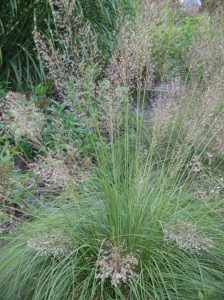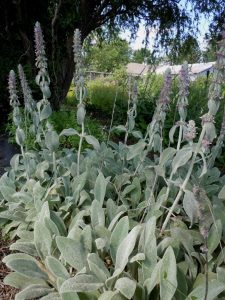Black Walnut Tolerant
Showing 89–96 of 106 results
-
Schizachyrium scoparium syn. Andropogon scoparium Little bluestem Z 3-9
Wispy, feather-like seedheads atop blue-grey foliage that turns plum-orange-red in fall.
Wispy, feather-like seedheads atop blue-grey foliage that turns plum-orange-red in fall
Size: 18" x 12"
Care: sun in well-drained soil.
Native: all No. America, Wisconsin native.
Wildlife Value: leaves are food for Skipper butterfly caterpillars and seeds food for songbirdsComanche used it to remedy syphilitic sores. Lakota made soft, wispy seedheads into liners for moccasins. Collected by French plant hunter André Michaux (1746-1802) in America’s prairies c. 1790
-
Sesleria autumnalis Autumn Moor Grass Z 5-9
Fresh-green spring narrow blades of grass in summer add airy purplish flower spikes with silver-white stamens on this low mounding, arching grass. Blades have a striking yellow-green color that sometimes develops a soothing golden autumn tint. Spike-like silvery flowers rise above the leaves and mature into soft tan seed heads by autumn.
Fresh-green spring narrow blades of grass in summer add airy purplish flower spikes with silver-white stamens on this low mounding, arching grass. Blades have a striking yellow-green color that sometimes develops a soothing golden autumn tint. Spike-like silvery flowers rise above the leaves and mature into soft tan seed heads by autumn.
Size: 16-18” x 12-18”
Care: sun to part shade in moist well-drained to well-drained soil, drought tolerant
Native: SE Europe east to Caucusus
Wildlife Value: walnut, salt and deer tolerant
Awards: Royal Horticultural Society Award of Garden Merit. Gardens Illustrated “100 Must-Have Garden Plants,” 2013.Collected in Slovenian mountains near Idria, c. 1760 by and 1st described in Flora Carniolica by Giovanni Antonio Scopoli (1723-1788) physician, naturalist and author. Sesleria is named to honor Leonardo Selser, 18th century Italian botanist and physician, contemporary and likely friend of Scopoli
-
Solidago caesia syn. Solidago axillaris Blue-stemmed goldenrod, Wreath goldenrod Z 4-9
Graceful, arching wands of clustered gold, with contrasting blue-green stems in September-October. One of the last perennials to bloom. Clump forming, noninvasive perennial.
Graceful, arching wands of clustered gold, with contrasting blue-green stems, in September-October. Clump forming, noninvasive perennial.
Size: 18-24” x 16-20”
Care: part shade to shade in well-drained soil, drought tolerant
Native: Nova Scotia to WI, south to FL and west to TX, Wisconsin native
Wildlife Value: With both nectar and pollen this attracts, bees, wasps and flies. It is host to caterpillars of some moths.The Latin name is a combination of solidus and ago, meaning “I make whole”, referring to its historic medicinal uses. According to William Cullina it has antioxidant, diuretic, astringent and antifungal properties and was used to treat urinary tract and yeast infections, sore throats and diarrhea. (W. Cullina, NEWFS, p. 197) Named by Swedish botanist Linnaeus in 1753.
-
Solidago riddellii syn. Oligoneuron riddellii Riddell’s goldenrod, Stiff goldenrod Z 3-7
Sunshine yellow dome-topped flowers Sept.- Oct. Differs from S. gramnifolia by fewer leaves and its leaves fold toward the center vein.
Sunshine yellow dome-topped flowers Sept.- Oct. Differs from S. gramnifolia by fewer leaves and its leaves fold toward the center vein.
Size: 3’x2’
Care: sun in moist to moist well-drained soil.
Native: swath down middle of No. Am. From Hudson Bay to AK, incl. Wisconsin native
Wildlife Value: Loved by butterflies for its nectar – Small copper, Monarch, Giant swallowtail, Gray hairstreak, Clouded Sulphur, Fritillary, Pearl crescent, & Cloudless sulphur. Attracts praying mantises. Resists deer.The name Solidago from solidus and ago meaning to bring together. First published by German botanist Joseph Frank (1782-1835) who named it riddellii in honor of John Riddell who had collected it in Ohio before 1835.
-
Solidago speciosa Showy goldenrod Z 3-8
Broad spikes of erect panicles of mustard yellow welcome late summer into autumn
Broad spikes of erect panicles of mustard yellow welcome late summer into autumn
Size: 3-5’ x 12-18”
Care: Sun, any soil
Native: Central & eastern US, Wisconsin native
Wildlife Value: Loved by butterflies for its nectar – Small copper, Monarch, Giant swallowtail, Gray hairstreak, Clouded Sulfur, Fritillary, Pearl crescent & Cloudless sulfur. Attracts praying mantises.Meskwaki applied an infusion made of roots to burns. Chippewa used this plant for many things – to stop bleeding in the mouth and lungs, reduce pain from strains and sprains, as a stimulant and tonic and, mixed with bear grease, for a hair ointment. HoChunk and Winnebago made a blood purifier and remedied incontinence. Collected by Thomas Nuttall, English planthunter (1786-1859) who wandered over all of No. America searching for plants, animals, birds, and rocks from 1809 to 1842.
-
Sporobolus heterolepsis Prairie dropseed Zone 3 – 9
Mound of graceful thinnest of grass blades
The description in the Chiltern Seeds catalog cannot be improved: “This is the most elegant and refined of the North American prairie grasses …the finest texture composed of the thinnest of thin, thread-like, glossy green blades,.. in autumn turning deep orange before fading to a light copper for the winter. In late summer the plants bear, on very slender stalks high above the foliage, unbelievably delicate, graceful flower panicles, excellent for cutting. ”One of internationally known garden designer Piet Oudolf’s 100 “MUST HAVE” plants, Gardens Illustrated 94 (2013)
Size: 2’ x 2’
Care: Full sun in well-drained soil
Native: from Canada in the north to Texas in the south, Wisconsin native
Wildlife Value: seeds are food for birds
Awards: Missouri Botanic Garden Plant of Merit & Great Plants for Great Plains Grass of the Year.Sporobolos is Greek from sporo meaning seed and ballein meaning to cast forth because the seed readily falls from the flower (or dropseed, the common name). Ojibwa “Medicine Society” used roots to cure sores & “remove bile.”
-
Stachys byzantina Lamb’s ears, Woolly betony, Wooly woundwort Z 4-8
Pale pink-lavender flowers on silver-gray spikes in summer with foliage as soft as a lamb’s ear.
Pale pink-lavender flowers on silver-gray spikes in summer with foliage as soft as a lamb’s ear.
Size: 12 x 12 spreading
Care: Full sun in moist well-drained to well-drained soil, low fertility
Native: Iran
Wildlife Value: Drought tolerant & deer resistant.Stachys is an old greek word meaning, “spike.” Stachys was believed to cure almost everything. Italians urged people to: “sell your coat and buy betony.” The common name “woundwort” describes the leaves’ function as bandages. Cultivated by George Washington at Mount Vernon.
-
Stachys minima syn. Stachys spathulata Dwarf betony Z 5-9
Atop a mound of spatula-shaped, crinkled leaves with scalloped edges rises a bounty of 4 to 5 inch tall spikes, each crowned with a hoard of tiny fuchsia-colored trumpets blowing their horns “look at me” in early to mid-summer.
Atop a mound of spatula-shaped, crinkled leaves with scalloped edges rises a bounty of 4 to 5 inch tall spikes, each crowned with a hoard of tiny fuchsia-colored trumpets blowing their horns “look at me” in early to mid-summer.
Size: 4-8" x 8-12" spreading slowly by rhizomes
Care: sun to part shade in moist well-drained soil
Native: South Africa
Wildlife Value: Deer resistant. Attracts small bees and butterfliesEnglish adventurer and naturalist William John Burchell (1781-1863) scoured South Africa from 1803 to 1815 collecting more than 50,000 specimens packed in 48 crates. In places unexplored he found insects, animals, fish and unknown plants, this being one. Although he published two volumes of his exploration, he did not finish the last, third volume, leaving another to write the botany. Premier English botanist George Bentham (1800-1884) took up the task authoring Labiatarum Genera et Species, published in 1834. He wrote the first published description and named this tiny plant with outsized charm.








